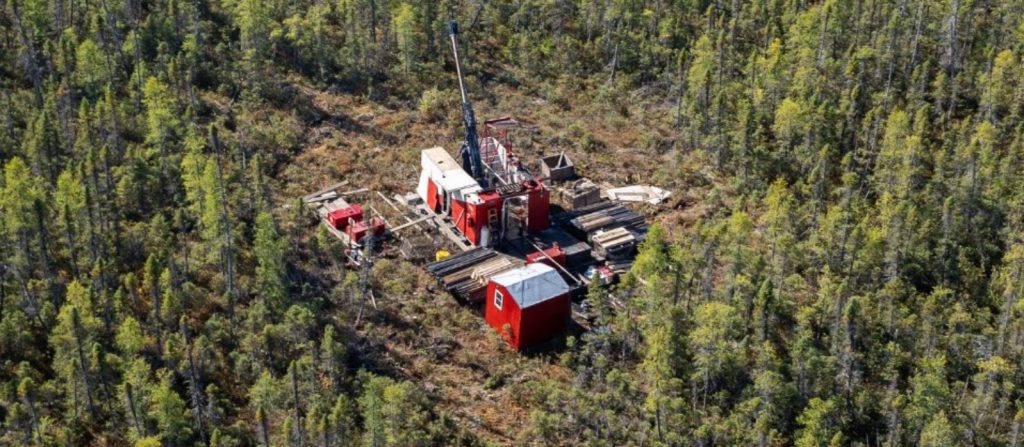Wallbridge Mining discovers new gold zone at Grasset, Quebec

Wallbridge Mining Company Ltd. [TSX-WM; OTCQX-WLBMF] has discovered a new area of gold mineralization at the Grasset East Flexure target area on its 100%-owned Grasset gold property, Quebec, located 15 km east of the company’s flagship Fenelon gold project. Scattered, gold-bearing quartz veins were intersected in nine of the 19 drill holes completed.
Highlights: Widespread gold-bearing quartz veining intersected in nine drill holes, so far over an approximately 1-km strike length (targets G1, G2 and G5).
Small visible gold grains were observed in four drill holes with assay results up to 3.20 g/t gold over 2.50 metres (included in a wider interval of 1.22 g/t Au over 8.50 metres). Assay results are pending for the visible gold-bearing portions of two of these holes.
The drill program was increased from the originally intended 5,000 metres to approximately 10,500 metres in 20 drill holes, with the final hole being completed.
“Our initial drill program on the grassroots Grasset Gold property is a good start in this new, unexplored area,”said Dr. Attila Pentek, Vice President, Exploration. “To find widespread gold mineralization in our first drill program in this entirely overburden covered area on the eastern end of our 97-kilometre-long property along the Detour-Fenelon Gold Trend speaks volumes to the vast untested potential of this and other target areas on our over 830-square-kilometre land package.”
Targets G1 & G2: The seven drill holes testing this target area have delineated widespread gold-bearing quartz veining at a relatively shallow depth, hosted within Timiskaming-like sediments and mafic volcanics, over a strike length of approximately 600 metres. The drilling has confirmed the presence of folded stratigraphy with targets G1 and G2 located at the hinge of the fold, in good accordance with the magnetic signature.
The first drill hole (GR-23-116) intersected a 70-metre-wide zone of quartz veining and sericite alteration at a vertical depth of only 100 to 150 metres, returning continuous elevated gold assays up to 4.36 g/t gold over 0.95 metres.
Similar geology and mineralization were observed in the other five drill holes, most notably with nine occurrences of visible gold specks in scattered quartz veins over a core length of 150 metres in hole GR-23-130. Assay highlights for this hole include 3.20 g/t gold over 2.50 metres within a wider interval of 1.22 g/t gold over 8.50 metres.
Two additional follow-up holes drilled at the end of the program intersected similar veins (GR-23-132 and GR-23-133), with both holes containing several occurrences of visible gold.
Assays results are pending for GR-23-130 (additional results), GR-23-132 and GR-23-133.
Target G5: Located 1 km to the west of Target G1, drill hole GR-23-119 intersected sporadic gold mineralization assaying up to 4.47 g/t gold over 1.00 metres. Two follow-up holes (GR-23-128 and GR-23-131) testing the same structure 1.7 km to the northwest, both intersected a 60- to 100-metre-wide zone of intense shearing with elevated silicification and sulfide mineralization. Assays are pending for both of these holes.
The Grasset Gold exploration program predominantly focused on the intersection of a large fold-structure with a flexure in the Sunday Lake Deformation Zone (SLDZ), the main structure controlling gold mineralization along the Detour-Fenelon Gold Trend.
The 2023 drill program is designed to define the geological framework of the Grasset East Flexure target area, and to test structures interpreted from recently collected high-resolution airborne magnetic data. Two main types of environments are targeted: northern contact of Timiskaming-like sedimentary unit with mafic volcanic rocks in areas of interpreted structural complexities (16 drill holes – targets G1, G2, G5, G6, G7 and G11); and interpreted structures and lithological contacts within the northern mafic volcanic package (4 drill holes – targets G3, G8, G9 and G10).
The Grasset East Flexure target area was never drill tested in the past. Originally, the Company intended to complete approximately 5,000 metres of diamond drilling on 11 targets over an area of 4.5 km by 3.5 km.
To further investigate this new mineralized area, the size of this inaugural drill program was increased to approximately 10,500 metres. Thus far, a total of 19 drill holes totaling 10,000 metres have been completed, testing 10 of the originally identified 11 targets. Today, the company reports final assay results for ten drill holes and partial assay results for two drill holes with results pending for 10 holes, including the final hole still being drilled. The drilling program is expected to be completed later this week.
Wallbridge’s flagship project, Fenelon Gold, is located on the prospective Detour-Fenelon Gold Trend property in Quebec’s Northern Abitibi region. An updated mineral resource estimate completed in January 2023 yielded significantly improved grades and additional ounces at the 100%-owned Fenelon and Martiniere projects, incorporating a combined 3.05 million oz indicated gold resources and 2.35 million oz inferred gold resources. Fenelon and Martiniere are located within an 830 km2 exploration land package controlled by Wallbridge. In addition, Wallbridge believes that the extensive land package is extremely prospective for the discovery of additional gold deposits.
Wallbridge has reported a positive Preliminary Economic Assessment on its Fenelon gold Project with an estimated average annual gold production of 212,000 ounces over 12.3 years.
